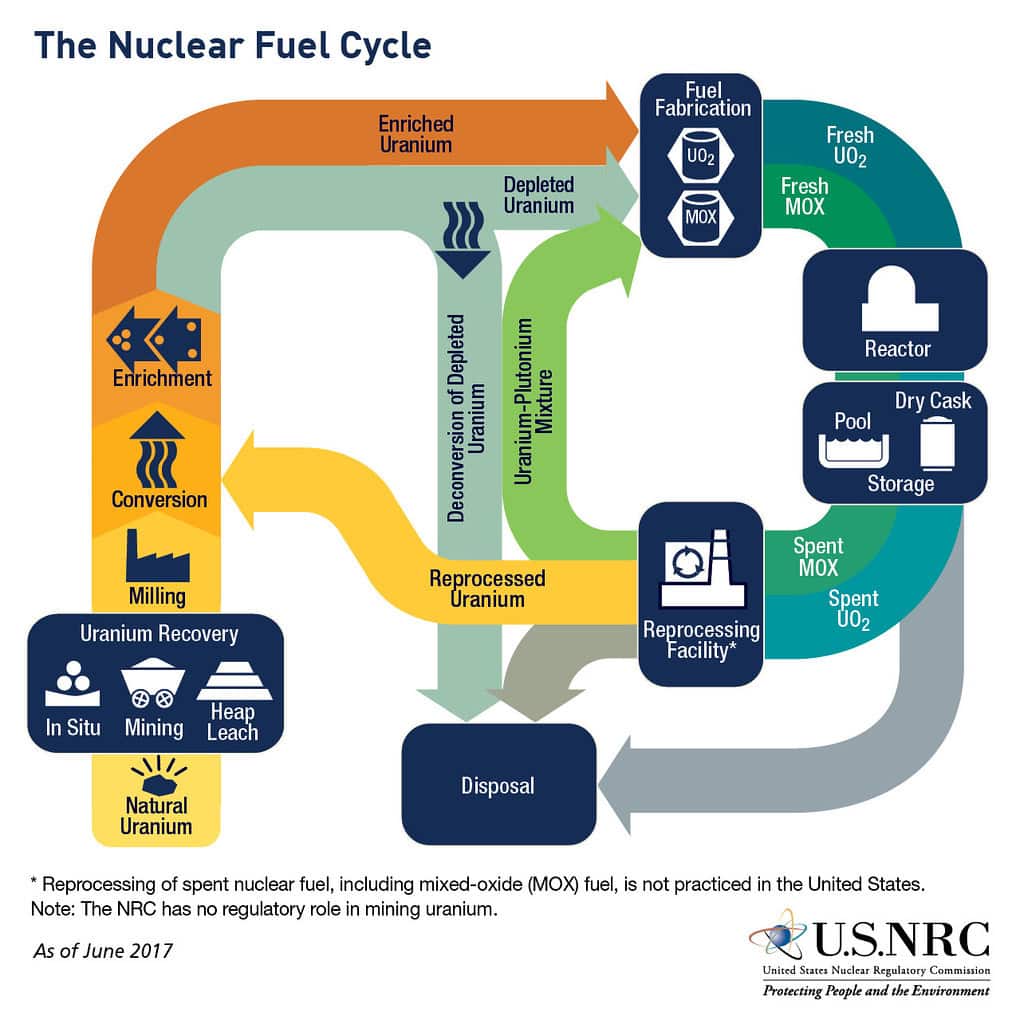Danger Nuclear Fuel Cycle
Take Action
Join With Us
Resources
Subscribe
A Cycle of Deadly Pollution
The Nuclear Fuel Cycle – Cycle of Pollution
Just as one can’t talk about coal plants without thinking about coal mining, the same is true for nuclear power plants. The fuel cycle of nuclear power starts with the mining of uranium ore that next is milled through physical and chemical means. The milled ore is then converted to nuclear fuel by a process called “enrichment,” which is followed by fabrication into fuel pellets. These fuel pellets are placed into long metal fuel rods. After a period of use in the nuclear reactor, the fission process creates other radioactive isotopes and the fuel pellets lose their ability to react and generate the heat that is turned into electricity. The now spent fuel rods are temporarily stored in spent fuel pools—essentially large swimming pools next to the reactor—awaiting the next step. Each of these steps pollutes the environment.

When the nuclear industry sells its product as “clean energy” that means nuclear power plants don’t emit greenhouse gases while they are operating. This narrow definition ignores the fossil fuels used throughout the nuclear fuel cycle. As the U.S. Energy Information Administration points out:
If fossil fuels are used for mining and refining uranium ore, or if fossil fuels are used when constructing the nuclear power plant, then the emissions from burning those fuels could be associated with the electricity that nuclear power plants generate.
Unlike the really “clean energy” sources of wind and solar power, nuclear power emits and discharges radioactive and chemical pollution to the air and water.
The nuclear fuel cycle also adds costs to nuclear power. During a recent 12-month period, the price for uranium alone increased a whopping 86 percent. And the nuclear fuel cycle adds instability to our energy supply. Right now we are dependent on foreign suppliers, including Russia, for uranium fuel. But that would get even worse if the U.S. were to build new so-called advanced reactors because the only source of fuel for those reactors is Russia.
Below in the Resources section you will find papers, articles, videos, etc. documenting the nuclear fuel cycle.
NWEA is working with other organization in the West to make sure consumers have safe, affordable, and reliable power.
NWEA is reaching out to the Northwest residents make them aware that nuclear energy is not a viable climate action.
NWEA is supporting the deployment of local energy sources that will keep electric rate affordable for all such as energy efficiency and solar.
Utilities in the Northwest are in the process of planning for reducing their carbon footprint and while some are looking at energy efficiency and conservation along with renewable, others are unfortunately looking to nuclear power. It's important we encourage those utilities seeking nuclear free options to continue down that path. At the same time, we need to let those utilities planning on nuclear power know they need to follow a nuclear free path. Nuclear power costs will only add to an increased costs for fixing an electric grid above and beyond what's needed for reliability. The utilities now considering nuclear power include Clark County PUD, Grant County PUD, and Pacific Power.
Action Needed Now!
Tell Your Electric Utility
Now is not the time to solve one problem with another, one that will increase electric rates and impact future generations with radioactive waste. Let your utility know you want your dollars to be used for energy efficiency, community renewables, and rooftop solar. Here are the utilities that we know are considering new nuclear reactors:
Clark Public Utility District - Grant County Public Utility District - Pacific Power
